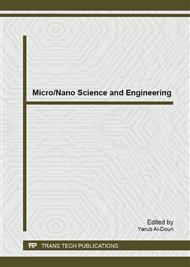[1]
H. J. Twitchett, Chemistry of the production of organic isocyanates, Chem. Soc. Rev. 3 (1974) 209-230.
Google Scholar
[2]
B. G. Soares, G. S. Amorim, F. G. Souza Jr, M. G. Oliveira and J. E. P. da Silva, The in situ polymerization of aniline in nitrile rubber, Synthetic Met. 156 (2006) 91-98.
DOI: 10.1016/j.synthmet.2005.09.045
Google Scholar
[3]
R. Zhao, C. Tan, Y. Xie, C. Gao, H. Liu and Y. Jiang, One step synthesis of azo compounds from nitroaromatics and anilines, Tetrahedron Lett. 52 (2011) 3805-3809.
DOI: 10.1016/j.tetlet.2011.05.054
Google Scholar
[4]
A. Puig, P. Ormad, P. Roche, J. Sarasa, E. Gimeno and J. L. Ovelleiro, Wastewater from the manufacture of rubber vulcanization accelerators: characterization, downstream monitoring and chemical treatment, J. Chromatogr. A. 733 (1996) 511-522.
DOI: 10.1016/0021-9673(95)00866-7
Google Scholar
[5]
Information on http: /www. epa. gov/opptintr/chemtest/pubs/sun92. pdf.
Google Scholar
[6]
U Tezel, L. P. Padhye, C. H. Huang and S. G. Pavlostathis, Biotransformation of nitrosamines and precursor secondary amines under methanogenic conditions, Environ. Sci. Technol. 45 (2011) 8290-8297.
DOI: 10.1021/es2005557
Google Scholar
[7]
Q. Jin, Z. Hu, Z. Jin, L. Qiu, W. Zhong and Z. Pan, Biodegradation of aniline in an alkaline environment by a novel strain of the halophilic bacterium, Bioresour. Technol. 117 (2012) 148-154.
DOI: 10.1016/j.biortech.2012.04.068
Google Scholar
[8]
F. Shahrezaei, Y. Mansouri, A. A. L. Zinatizadeh and A. Akhbari, Photocatalytic degradation of aniline using TiO2 nanoparticles in a vertical circulating photocatalytic reactor, Int. J. Photoenergy. (2012) 1- 8.
DOI: 10.1155/2012/430638
Google Scholar
[9]
H. T. Gomes, B. F. Machado, A. Ribeiro, I. Moreira, M. Rosário, A. M. T. Silva, J. L. Figueiredo and J. L. Faria, Catalytic properties of carbon materials for wet oxidation of aniline, J. Hazard. Mater. 159 (2008) 420-426.
DOI: 10.1016/j.jhazmat.2008.02.070
Google Scholar
[10]
X. Yang, Q. Guan and W. Li, Effect of template in MCM-41 on the adsorption of aniline from aqueous solution, J. Environ. Manage. 92 (2011) 2939-2943.
DOI: 10.1016/j.jenvman.2011.07.006
Google Scholar
[11]
L. E. Vijan and M. Neagu, Adsorption isotherms of phenol and aniline on activated carbon, Rev. Roum. Chim. 57 (2012) 85-93.
Google Scholar
[12]
A. Thomas, A. Fischer, F. Goettmann, M. Antonietti, J. -O. Muller, R. Schlogl and J. M. Carlsson, Graphitic carbon nitride materials: variation of structure and morphology and their use as metal-free catalysts, J. Mater. Chem. 18 (2008).
DOI: 10.1039/b800274f
Google Scholar
[13]
A. Vinu, Two-dimensional hexagonally-ordered mesoporous carbon nitrides with tunable pore diameter, surface area and nitrogen content, Adv. Funct. Mater. 18 (2008) 816-827.
DOI: 10.1002/adfm.200700783
Google Scholar
[14]
E. Haque, J. W. Jun, S. N. Talapaneni, A. Vinu and S. H. Jhung, Superior adsorption capacity of mesoporous carbon nitride with basic CN framework for phenol, J. Mater. Chem. 20 (2010) 10801-10803.
DOI: 10.1039/c0jm02974b
Google Scholar
[15]
F. Goettmann, A. Fischer, M. Antonietti and A. Thomas, Chemical synthesis of mesoporous carbon nitrides using hard templates and their use as a metal-free catalyst for Friedel–Crafts reaction of benzene, Angew. Chem. Int. Ed. 45 (2006) 4467-4471.
DOI: 10.1002/anie.200600412
Google Scholar
[16]
A. Araújo, M. B. Souza, A. S. Silva, A. G. Pedrosa, J. F. B. Aquino and A. S. L. S. Coutinho, Study of the adsorption properties of MCM-41 molecular sieves prepared at different synthesis times, Adsorption. 11 (2005) 181-186.
DOI: 10.1007/s10450-005-4911-1
Google Scholar
[17]
S. Jana, B. Dutta, H. Honda and S. Koner, Mesoporous silica MCM-41 with rod-shaped morphology: Synthesis and characterization, Appl. Clay. Sci. 54 (2011) 138-143.
DOI: 10.1016/j.clay.2011.07.018
Google Scholar


